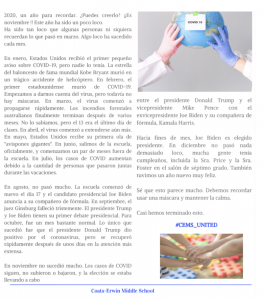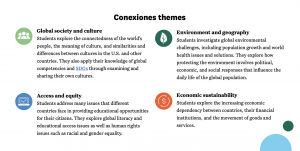Many post-elementary immersion students need support in bridging the gap between their experiences in dual language classrooms at the elementary level and more advanced high school language courses. One of the biggest challenges in solving this problem is designing and implementing a successful middle school program that supports articulation across grade levels, and caters to a wide audience of students, from heritage Spanish speakers to English-dominant students.
During the 30+ years that we’ve been working with district and school partners to design and implement successful dual language programs, such as our middle school dual language program, Conexiones, we’ve learned some important lessons, which we’ve summarized below.
Plan for full articulation early
Districts that already have, or are planning to start, dual language programs should consider long-range planning. While an elementary-only program can help students achieve significant levels of biliteracy and proficiency in both the home and the second language, the goal is to create a pathway for students to take full advantage of the benefits language studies can have in their educational careers and futures. With that in mind, engaging early in the discovery of options that will be feasible at the middle school level is important.
Involving the middle and high school language departments in understanding the needs of students who come from a dual language elementary program that includes heritage students takes time, and therefore, it should happen during the design of the program, or early in the implementation of the elementary program.
Our dual language services team spends at least one to two years in the discovery, planning, and implementation of the program. In most cases, the realization that students can opt for honors, advanced placement language courses, IB, or Credit by Demonstrated Mastery (CDM) options creates greater possibilities for high school programs, and requires logistical planning and preparation ahead of time.
Include your heritage speakers
A successful middle school dual language program is a great resource to support, enhance, and strengthen the cultural and linguistic backgrounds of your heritage speakers. It provides them with opportunities to practice their home language skills in a variety of contexts while exploring the cultures of Spanish-speaking communities from around the world, as well as their own.

Fredy Parra, who teaches Conexiones to a group of English and heritage Spanish speakers in Harnett County, used the Conexiones curriculum to create opportunities across learner groups. Together with his students, his class decided that a good way to support each other’s language development and their school and local community was to write a bilingual newspaper whose first edition went live recently. This is an example of a page from their Spanish November issue.
The Conexiones group writes in Spanish, the ESL group writes in English, and they each have opportunities to author and edit for each other. Fredy states, “They feel like their language skills matter because they are working on content and helping their partners use the language effectively.”
Heritage speakers also benefit the most from a program that invites them to examine their own cultural identity and explore their heritage cultures from multiple perspectives. Include in your dual language program opportunities for students to practice their language skills within authentic cultural and social frameworks of regions from the Spanish-speaking world. This approach has led to a sense of belonging and a feeling of pride in the heritage speakers in our Conexiones program, which further strengthens their learning.
Build programs that develop critical thinking skills
Middle school dual language programs usually have to contend with solving logistical issues of scheduling, but are critical in building an effective transition from elementary school to high school. Besides the logistics, the programs must focus on developing students as critical thinkers, which will help them master more complex language skills by learning to gather and analyze information from multiple sources, argue, summarize, and communicate to their peers and others.
The Conexiones curriculum is built on overarching themes (shown below) tied to the United Nations’ Sustainable Development Goals (SDGs). This approach helps to support more robust linguistic skills as well as exposure and familiarity to broader content areas in which students are able to further develop the core competencies of a global leader.

Adriana Rueda, has been teaching Conexiones for several years with students in 6th, 7th, and 8th grades at The International School at Gregory. As she works with a diverse group of students, which includes heritage Spanish and English speakers, she affirms that what makes this course a successful experience is that, “It offers them the opportunity to increase their language skills while working on cross-curricular projects; it’s learning by doing.”
Students have to research, analyze, collaborate, and present information to others by using technology tools to formulate their projects through the target language. Adriana raves about how students have shown growth in their language skills, but also in their ability to reference global issues since the course is centered around the development of global competencies and the SDGs.
“When you revisit a topic each year of the course, students’ ability to critically analyze and pull information that is built on what they learned previously is a powerful experience.” -Adriana Rueda
Both Fredy and Adriana state that Conexiones offers their dual language and heritage speakers the opportunity to continue learning, developing critical language skills as well as important cross-cultural and global competencies that are not always part of traditional language courses. Adriana says it is not always easy to teach cultural aspects, explaining that, “You have to understand your own biases and be really careful with students.”
She is referring to the treatment of sensitive cultural notions that are important to develop, in order to become effective global leaders. Fredy says that, in his experience, heritage students, “… relate really easily to many of the cultural references from the Conexiones curriculum because of their background. When it comes to global competencies, both groups of students are on the same level. They are all becoming aware, discovering, and learning together.”
Main takeaways
Dual language programs should plan to offer post-elementary dual language and heritage students opportunities to continue to develop their second language skills. It is critically important for the academic success of second language learners that they continue to have language support through at least middle school. For native English students, the added opportunity for language development in a community with native Spanish speakers is a great boost for their own language development skills. The programs offer real opportunities for collaboration across language groups around the study of current issues as students develop their global leadership skills.
With Conexiones, student performance on proficiency assessments shows that those participating in the program continue to make progress toward higher performance levels. In the classroom, both Adriana and Fredy share that, over time, students’ work demonstrates improved reading, writing, and presentational language skills.
As you develop your own middle school dual language program and long-range strategy, consider how each of the elements discussed might take shape within your districts and schools. Keep talking to key people who can help shape and make your program a success. As we’ve seen with Conexiones, successful dual language programs help students succeed academically, and, as importantly, they help build bridges among students, and have a direct impact on our local and global communities.
At Participate Learning, we are committed to ensuring equitable access to quality programming for students that supports their academic success and development as global leaders. To learn more about how to implement a successful middle school dual language program at your school, check out our Conexiones webpage.




